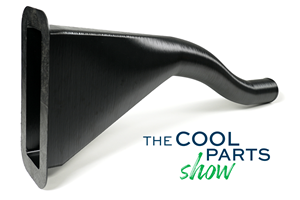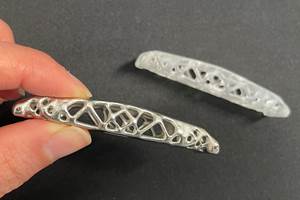Xolo Collaborates With Swarovski to Develop Xolography-Based Crystal Glass Manufacturing
Xolo says its Xolography volumetric printing technology enables the creation of intricate glass components with unprecedented clarity and detail.
Swarovski, well known for crystal and jewelry manufacturing, is working with Xolo, a provider of volumetric 3D printing technology, on a project that aims to directly print crystal glass, to achieve new standards in precision and speed for customized crystal manufacturing.
Xolo’s Xolography volumetric printing technology is said to enable the creation of intricate glass components with unprecedented clarity and detail. This collaboration emphasizes Swarovski's commitment to innovation with a focus on consumer needs. The project has been co-developed with a group from the University of Padova (Padova, Italy) led by Professor Paolo Colombo, a professor of Materials Science and Technology in the Department of Industrial Engineering.
Volumetric 3D printing enables objects to be built in a single, layer-free process, thereby offering significant speed and material efficiency advantages. Xolo’s Xolography technology achieves high precision by projecting light with two wavelengths into resin inside sealed cuvettes, enabling the rapid creation of complex structures.
This method is well suited for printing biocompatible materials and, as well as technical objects, such as optical elements with smooth surfaces. High-viscosity materials can be printed without support structures, enabling isotropic material properties and high-performance direct oligomer printing. This makes xolography particularly useful for scientific research and advanced manufacturing.
For Swarovski, this partnership is a strategic move to demonstrate its dedication to remaining at the forefront of technological advancements. By collaborating with Xolo, Swarovski aims to push the boundaries of what’s possible in crystal manufacturing, aligning with its vision to blend tradition with pioneering technology.
Xolo is equally enthusiastic about the potential of this partnership. “Working alongside a prestigious company like Swarovski is not only an honor but also a tremendous opportunity to showcase the capabilities of Xolography in a new, dynamic field,” says Dirk Radzinski, Xolo CEO.
Professor Colombo and Swarovski recognized the potential of Xolography early on in their open innovation program and Colombo has utilized the technology in groundbreaking ways. His expertise and pioneering work provide invaluable insights that will greatly enhance the scope and impact of this collaboration.
Future Prospects
As this collaboration progresses, both Swarovski and Xolo anticipate setting a new industry standard that could eventually be adopted across various sectors of glass manufacturing. The collaborators say this initiative is not just a transformation of technique but a redefinition of the material’s role in modern design and functionality.
Founded in 1895 in Austria, Swarovski designs, manufactures and sells some of the world’s finest crystals, as well as Swarovski Created Diamonds and zirconia, jewelry and accessories, as well as home décor and crystals for the automotive industry. Swarovski Crystal Business is represented in over 140 countries worldwide with 2,300 Swarovski boutiques complemented by selected multibrand partners and employs 16,600 people. Together with its sister companies Swarovski Optik (optical devices) and Tyrolit (abrasives), Swarovski Crystal Business forms the Swarovski Group.
Xolo has been a pioneer in the field of volumetric 3D printing with its proprietary Xolography technology. Based in Berlin, the company is dedicated to reshaping manufacturing across industries, enhancing product quality and reducing production timelines. The company stems from a collaboration among experts in photo-switchable molecules, photonic imaging and deep science startup creation. Led by Professors Stefan Hecht and Martin Regehly, and CEO Dirk Radzinski, Xolo works to transform advanced scientific research into innovative 3D printing solutions.
Related Content
Aircraft Ducts 3D Printed in Composite Instead of Metal: The Cool Parts Show #68
Eaton’s new reinforced PEKK, tailored to aircraft applications, provides a cheaper and faster way to make ducts compared to formed aluminum.
Read MoreCopper, New Metal Printing Processes, Upgrades Based on Software and More from Formnext 2023: AM Radio #46
Formnext 2023 showed that additive manufacturing may be maturing, but it is certainly not stagnant. In this episode, we dive into observations around technology enhancements, new processes and materials, robots, sustainability and more trends from the show.
Read MorePossibilities From Electroplating 3D Printed Plastic Parts
Adding layers of nickel or copper to 3D printed polymer can impart desired properties such as electrical conductivity, EMI shielding, abrasion resistance and improved strength — approaching and even exceeding 3D printed metal, according to RePliForm.
Read More3D Printing with Plastic Pellets – What You Need to Know
A few 3D printers today are capable of working directly with resin pellets for feedstock. That brings extreme flexibility in material options, but also requires greater knowledge of how to best process any given resin. Here’s how FGF machine maker JuggerBot 3D addresses both the printing technology and the process know-how.
Read MoreRead Next
Alquist 3D Looks Toward a Carbon-Sequestering Future with 3D Printed Infrastructure
The Colorado startup aims to reduce the carbon footprint of new buildings, homes and city infrastructure with robotic 3D printing and a specialized geopolymer material.
Read MoreCrushable Lattices: The Lightweight Structures That Will Protect an Interplanetary Payload
NASA uses laser powder bed fusion plus chemical etching to create the lattice forms engineered to keep Mars rocks safe during a crash landing on Earth.
Read More3D Printed Polymer EOAT Increases Safety of Cobots
Contract manufacturer Anubis 3D applies polymer 3D printing processes to manufacture cobot tooling that is lightweight, smooth and safer for human interaction.
Read More





















